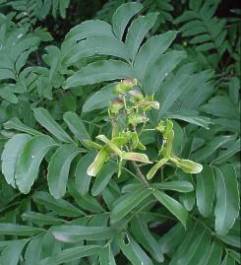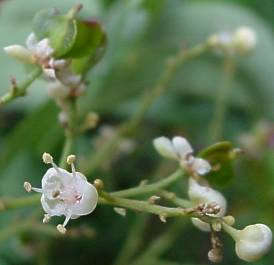Atalaya alata
Atalaya alata (Sim) H.M.L.Forbes
Family: Sapindaceae
Common names: Lebombo krantz ash (Eng.); Lebombo kransesseboom (Afr.); umzondo, umnondo (Zulu)
SA Tree No: 427
Introduction
Introduce a finer texture in your garden by planting Atalaya alata.

Description
Description
Atalaya alata is a small to medium-sized deciduous tree, with a sparsely branched crown. The compound leaf has 5 to 7 pairs of leaflets. They are markedly asymmetrical, often almost sickle-shaped. The leaf margins are toothed, particularly along the upper edge.

The flowers are small and white and appear in spring to early summer, September to November. The fruit is three-winged, 1 or 2 of the wings often being partially developed. The fruit ripens in autumn.

The wood is fairly lightweight, brittle, fine-textured and pale yellow-white. This tree resembles Clausina anisata (perdepis), although Atalaya alata leaves do not smell when they are crushed.
Conservation Status
Status
Atalaya alata is widely distributed and not declining (Raimondo et al. in prep.).
Distribution and habitat
Distribution description
Atalaya alata is found on rocky slopes of the Lebombo Mountains in northern Kwa-Zulu-Natal, eastern Gauteng, Swaziland and Mozambique. It is sensitive to cold, and it should be grown in warm conditions.
Derivation of name and historical aspects
History
The specific epithet alata is from a Latin word alatus, meaning winged, and refers to the winged fruit. There are nine species of Atalaya in Australia, Indochina and southern Africa. There are three species in South Africa: A. alata, A. capensis and A. natalensis.
Ecology
Ecology
In the wild this tree is browsed by elephant.
Uses
Use
In the garden Atalaya alata gives a finer texture in its leaves and bark. It is not known to be of any cultural use other than its suitability for garden use.

Growing Atalaya alata
Grow
Atalaya alata is grown from seed. The seeds are collected when the fruit is pale brown and ripe, and before it falls. The seeds are easily cleaned by crushing the seed pod by hand. Treat the seeds with a fungicide to protect them from pre-emergence damping off. Sow seed in summer. Prepare a well-drained, well-aerated soil mix in a seed tray. Spread the seeds in the tray and cover them with a layer of bark or river sand. Water the seed tray with a very fine nozzle, place it in a warm place and always keep it moist. The seeds will take 4-6 weeks to germinate.
References
- Coates Palgrave, K. 1983. Trees of southern Africa. Struik, Cape Town.
- Leistner, O.A. (ed.). 2000. Seeds plants of southern Africa : families and genera. Strelitzia 10. National Botanical Institute, Pretoria.
- Palmer, E. & Pitman, N. 1972. Trees of southern Africa. Balkema, Cape Town.
- Pooley, E. 1993. The complete field guide to trees of Natal, Zululand and Transkei. Natal Flora Publications Trust, Durban.
- Raimondo et al. in prep. National Red List of threatened plants of South Africa. Strelitzia. South African National Biodiversity Institute, Pretoria.
- Van Wyk, A.E. (Braam) & Van Wyk, P. 1997. Field guide to trees of southern Africa. Struik, Cape Town.
Credits
Giles Mbambezeli
Kirstenbosch National Botanical Garden
October 2008
Plant Attributes:
Plant Type: Tree
SA Distribution: KwaZulu-Natal, Limpopo, Mpumalanga
Soil type: Sandy, Loam
Flowering season: Early Summer
PH: Acid, Neutral
Flower colour: White
Aspect: Full Sun
Gardening skill: Average
Special Features:
Horticultural zones









Rate this article
Article well written and informative
Rate this plant
Is this an interesting plant?
Login to add your Comment
Back to topNot registered yet? Click here to register.